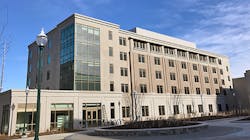4 buildings at America University receive LEED Gold certification
Four buildings on the East Campus of American University in Washington, D.C., have received LEED Gold certification for their sustainable design and construction.
The university says three residence halls—Duber, Constitution, and Federal—and the Don Myers Technology and Innovation Building met the U.S. Green Building Council's requirements for design, construction, operations, and maintenance
To receive its LEED Gold status, East Campus incorporated the following elements:
- 100% of the buildings receive their power from green electricity
- 97% of on-site construction waste was diverted from landfill
- 27% more energy-efficient than standard buildings
- 21% of materials used in its construction was sourced within a 500-mile radius
- 13,000 square feet of green roofs
East Campus has a computerized thermostat to regulate temperature, providing optimum air quality and thermal comfort. The buildings use sealants, paints, and furniture with low volatile organic compounds (VOCs) to provide a more healthful environment for occupants. State-of-the-art ventilation and air filtration further ensure air safety and quality.
Sustainability Analyst Courtney Stoner says, “Even though some of the sustainable features on East Campus aren’t visible to everyday occupants and visitors, behind the scenes, they are integral to keeping the building energy-efficient and comfortable.”
The buildings’ ultra-low-flow faucets, toilets, and urinals use 43% less water than standard buildings, saving about five million gallons of water annually. This helps to decrease the amount of wastewater that goes to wastewater treatment facilities. The native and adaptive plants in the landscape of East Campus also help to conserve water by reducing the need for irrigation.
East Campus also supports transportation methods and amenities that help reduce the effects of greenhouse gas emissions and air pollution. It is readily accessible to public transportation (shuttle and Metro bus, Metro rail, and bike share locations) and features a market, fitness center, and myriad green-friendly conveniences.
About the Author
Mike Kennedy
Senior Editor
Mike Kennedy, senior editor, has written for AS&U on a wide range of educational issues since 1999.
